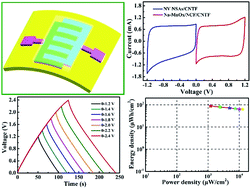Flexible quasi-solid-state 2.4 V aqueous asymmetric microsupercapacitors with ultrahigh energy density†
Abstract
Extensive research efforts have recently been devoted to the development of high-energy-density flexible microsupercapacitors (MSCs) to satisfy the rapidly increasing demands for wearable and portable electronics. However, the widespread application of MSCs in high-energy-consuming personal electronic devices has been hindered by their low operating voltages and unsatisfactory specific capacitances. Here, we demonstrate a simple and cost-effective cut-and-transfer method to fabricate flexible quasi-solid-state 2.4 V aqueous asymmetric MSCs (AMSCs) by employing hierarchical Na-MnOx nanosheets on 3D nitrogen-doped carbon fibers as the positive electrode and VN nanosheet arrays as the negative electrode. The resulting AMSCs take advantage of the high specific capacitance and wide electrochemical potential spectrum of the electrode materials to yield a remarkable specific capacitance of 109.5 mF cm−2 and admirable energy density of 87.62 μW h cm−2, outperforming most previously reported MSCs. Thus, this work provides a new way to develop high-voltage aqueous AMSCs for next-generation wearable energy-storage devices.

- This article is part of the themed collection: 2018 Journal of Materials Chemistry A HOT Papers


 Please wait while we load your content...
Please wait while we load your content...